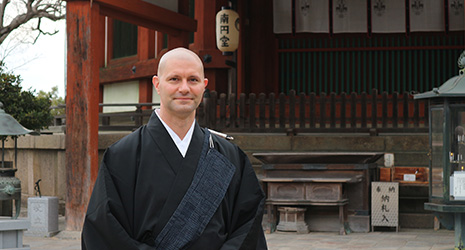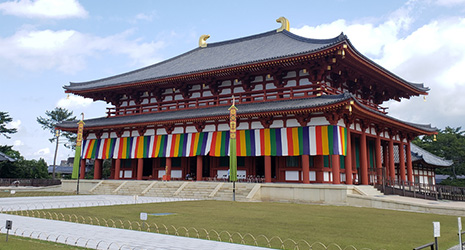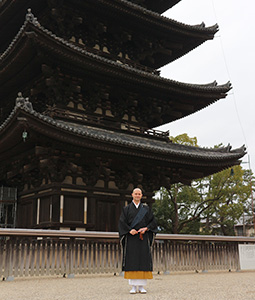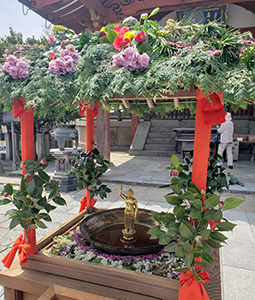March 2023
Passing on the Wisdom of the Buddha at Kohfukuji Temple in Nara

Gyoei Saile at Kohfukuji Temple 
The newly reconstructed Central Golden Hall (Chukondo) of Kohfukuji Temple, which was completed in 2018

Saile by the Five-storied Pagoda of Kohfukuji Temple 
Icon of Siddhartha Gautama, the historical founder of Buddhism, also known as Shakyamuni Buddha

Gyoei Saile is a Buddhist Priest at Kohfukuji Temple in Nara. Originally from Germany, he now divides his time between religious rites and running the temple, while also passing on his understanding of Buddhism to both foreign and Japanese visitors.

The city of Nara in Nara Prefecture was founded as the capital of Japan in the early 8th century*. In 1998, the temples, shrines, and former imperial palace site that together comprise the core of the city were designated a UNESCO World Heritage Site under the inscription “Historic Monuments of Ancient Nara.” One of these monuments is Kohfukuji, a famous Buddhist temple said to have been founded in the year 669.
Gyoei Saile is a priest at Kohfukuji Temple. The dignified appearance evoked by the traditional robes he wears unselfconsciously and the gentle smile on his face speak of the days and years that he has spent here training as a monk.
Born in Hamburg, Germany, Saile moved to the United States in his teens, where he attended a high school that happened to be offering Japanese language courses. Intrigued, he began to study Japanese, which led him to become interested in Japanese and East Asian culture. He continued his education at the University of California, Berkeley, where he majored in Japanese classical literature.
Saile explains, “I originally began to study Buddhism in order to understand the way in which it influenced the development of Japanese culture. At some point thereafter, I became interested in what is called Nanto Buddhism, or the ‘Buddhism of the Southern Capital,’ primarily because Nanto Buddhism has been almost completely neglected by Western scholars so far.”

Nanto Buddhism, sometimes also called Nara Buddhism, refers to a group of doctrinal traditions that were introduced to Japan in the 7th and 8th centuries, and have continued to be transmitted in temples of Nara ever since. At the height of Nara’s splendor as the capital of Japan, many learned monks from Japan and abroad gathered in the city, making it a major international center of the Buddhist faith. After the capital was moved 40 kilometers further north to what is now the city of Kyoto at the end of the 8th century, the area around Nara came to be called “Nanto” (Southern Capital), and the Buddhist schools based in the city have collectively been called Nanto Buddhism to this day.
After graduating from UC Berkeley, Saile completed a Master’s Degree in Buddhist literature at the Osaka University of Foreign Studies before returning to Berkeley to begin a PhD in Buddhist Studies. Following the completion of his coursework, he returned to Japan to conduct dissertation research as a visiting scholar at Ryukoku University, a Buddhist university located in Kyoto. Although based at Ryukoku, Saile chose to live in Nara in order to be closer to the head temples of the Buddhist tradition in which he specialized. This tradition, known as the Hosso School, is one of the original schools of Nara Buddhism, and the oldest Buddhist sect in Japan today. In the course of his research, Saile frequently visited the two head temples of the Hosso School, Kohfukuji and Yakushiji, and began to help out with daily chores (samu) such as cleaning, and with the preparations for the many rituals conducted in these temples.
Things changed drastically in the fall of 2011, when one of the priests of Kohfukuji approached Saile and told him that he was entering a retreat to prepare for the ryugi examination, and wanted Saile to join him as his doji (attendant). The term ryugi, which literally means “to establish an interpretation,” refers to an examination in the form of an oral doctrinal debate that closely resembles the qualifying exams for a PhD in modern academia. In the contemporary Hosso School, a priest may take this exam only once in his life, and if he completes it successfully, he qualifies to become abbot of Kohfukuji, and head of the Hosso School. One of the most important roles in this practice is played by the doji, who not only takes care of the candidate’s daily needs while in retreat, but also practices the various debates that comprise the exam with him. In order to serve as doji, one must leave the secular world behind and be ordained as a priest. After carefully considering his proposal, Saile decided to accept the request, and has served as a priest at Kohfukuji Temple ever since.
Saile explains that as part of the preparation for the ryugi exam, “the candidate enters a preparatory retreat, during which he is expected to study for 24 hours a day. In order to ensure that he does not fall asleep, he is confined to a small space in which he cannot lie down or stretch his legs. He spends the next three weeks in this space memorizing several books’ worth of classical Chinese Buddhist texts. Following this is the actual exam, which takes about two hours to complete.” As a specialist in Hosso doctrine who already had plenty of experience reading ancient manuscripts, Saile fulfilled his role as doji with distinction.

In 2019, Saile himself was given the opportunity to undertake this grueling retreat, and became the first foreign-born priest to successfully complete the ryugi exam in the 1,000-year history of this practice. In the Hosso School, the ryugi is not a yearly event, but is only held when a priest qualifies to stand as candidate. Hence, many years may pass before the ryugi is performed again. At the time he took his exam, Saile was 41 years old, and had been a priest at Kohfukuji for eight years.
Since the completion of the ryugi, Saile has continued to practice as a priest while also serving as an administrator of the temple. One of his main roles at Kohfukuji is to give tours of the temple in Japanese, English and occasionally German. In addition, he frequently gives talks and lectures on his school’s doctrines, and continues to share the insight he has gained into the Buddhist teachings with the general public.
The fundamental doctrine of the Hosso School is known as yuishiki, or “consciousness-only.” According to this teaching, reality as we experience it does not exist outside of or apart from us, but is rather a creation of our own minds. According to Saile, “although Buddhist doctrines can sound complicated and even counterintuitive at times, Shakyamuni (an honorific title for the historical Buddha) was really just trying to explore what it means to be a human being. The question of what it is to live, or perhaps how to live life in a meaningful way, is one that his successors have continued to ponder right up to the present day. And if one phrases it this way, I think that it’s a very relatable question that applies equally to all human beings regardless of their beliefs or country of origin.”
* Nara was the capital of Japan between 710 and 784. Modeled after Chang’an, the capital city of the Tang Dynasty, it is said to have been home to more than 100,000 people.

